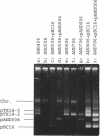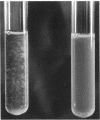Abstract
Mobilizations of pBC16 and pAND006, containing the replicon of the Bacillus thuringiensis subsp. israelensis plasmid pTX14-3, between strains of B. thuringiensis subsp. israelensis were examined. Transconjugants appeared after a few minutes and reached a maximum frequency after approximately 2 h. Plasmid pBC16 was mobilized at a frequency approximately 200 times that of pAND006. However, pAND006 was consistently transferred, suggesting that the replicon of pTX14-3 is sufficient to sustain mobilization in B. thuringiensis subsp. israelensis. A specific protease-sensitive coaggregation between strains of B. thuringiensis subsp. israelensis was found to be unambiguously correlated with plasmid transfer. Two aggregation phenotypes, Agr+ and Agr-, were identified in this subspecies. Aggregation disappeared when the optical density of the mating mixture at 600 nm exceeded approximately 1, and it did not reappear upon dilution. Aggregation was shown to involve interactions of cells with opposite aggregation phenotypes, and evidence of a proteinaceous molecule on the surface of the Agr- that is cells involved in aggregation formation is presented. Matings and selection for the presence of two antibiotic resistance plasmids followed by identification of the host cell revealed that mobilization was unidirectional, from the Agr+ cell to the Agr- cell. The aggregation phenotype was found to be transferred with high frequency (approximately 100%) in broth matings, and the appearance of Agr- isolates from Agr+ strains suggested that the loci involved in aggregation formation are located on a plasmid. No excreted aggregation-inducing signals were detected in the supernatant or culture filtrate of either the donor, the recipient, or the mating mixture.
Full text
PDF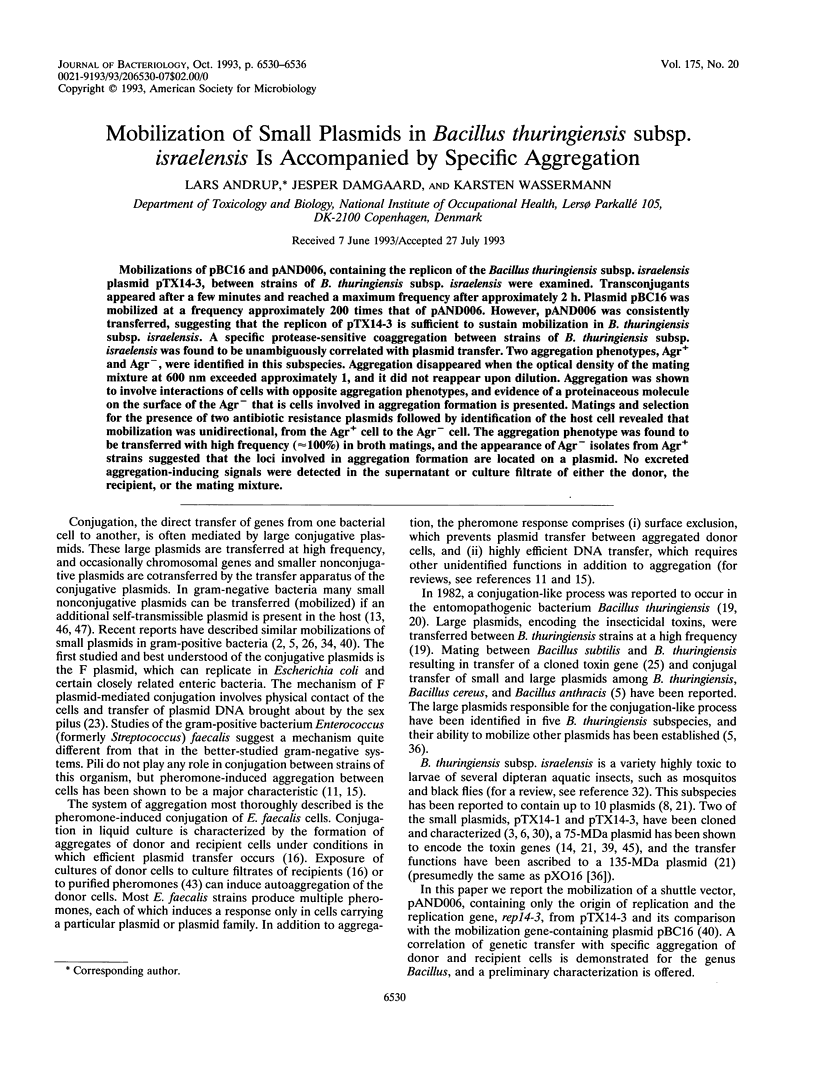
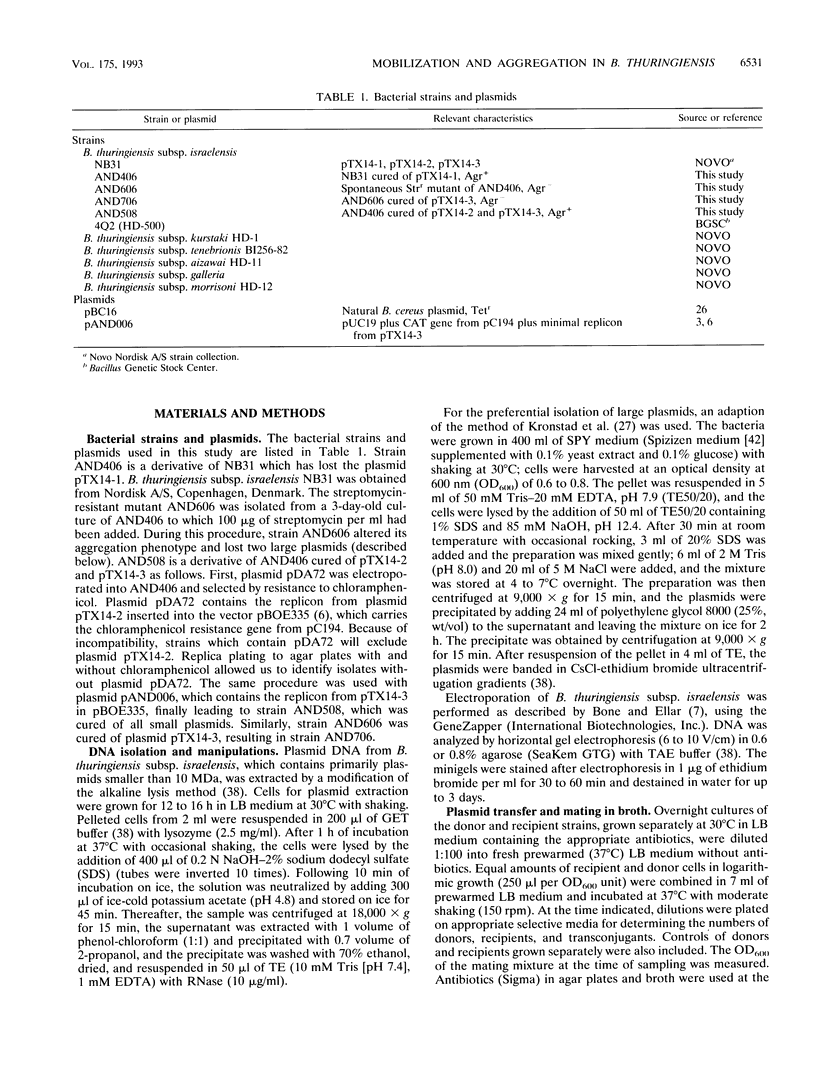




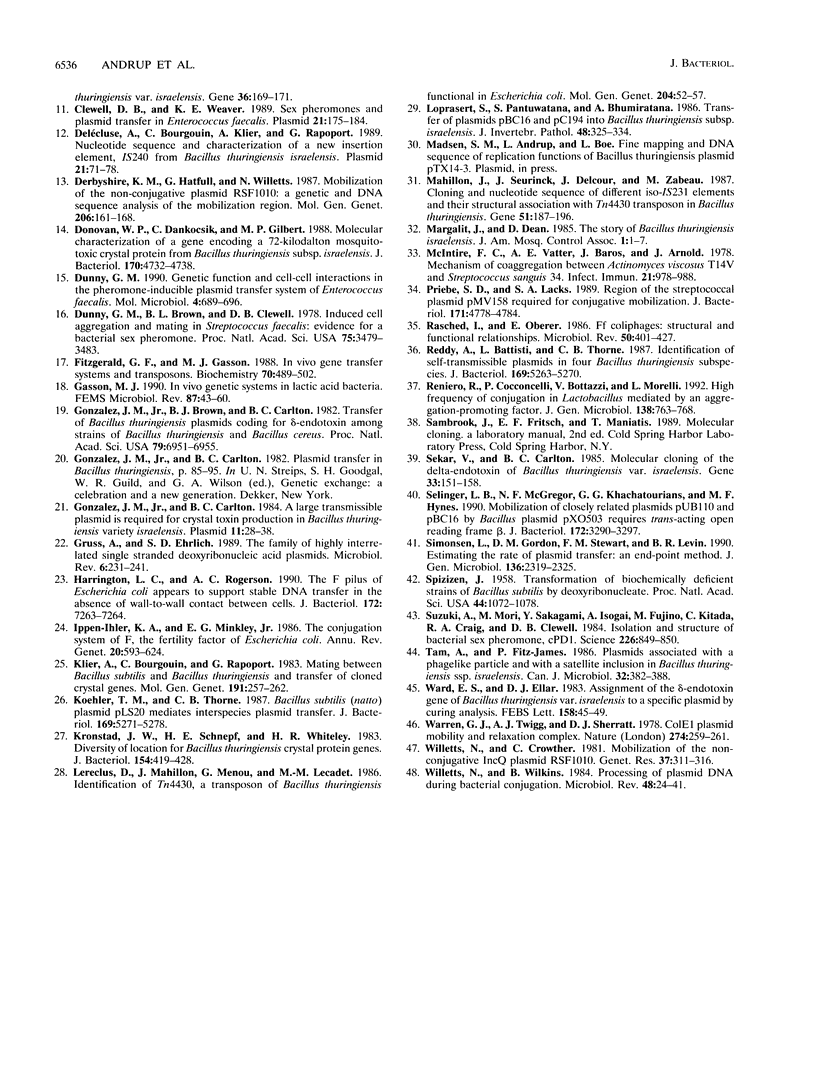
Images in this article
Selected References
These references are in PubMed. This may not be the complete list of references from this article.
- Abaas S., Holme T. Spontaneous aggregation of streptococcus mitis ATCC 903. Scand J Dent Res. 1981 Oct;89(5):366–373. doi: 10.1111/j.1600-0722.1981.tb01695.x. [DOI] [PubMed] [Google Scholar]
- Andrup L., Bolander G., Boe L., Madsen S. M., Nielsen T. T., Wassermann K. Identification of a gene (mob14-3) encoding a mobilization protein from the Bacillus thuringiensis subsp. israelensis plasmid pTX14-3. Nucleic Acids Res. 1991 May 25;19(10):2780–2780. doi: 10.1093/nar/19.10.2780. [DOI] [PMC free article] [PubMed] [Google Scholar]
- Aronson A. I., Beckman W. Transfer of chromosomal genes and plasmids in Bacillus thuringiensis. Appl Environ Microbiol. 1987 Jul;53(7):1525–1530. doi: 10.1128/aem.53.7.1525-1530.1987. [DOI] [PMC free article] [PubMed] [Google Scholar]
- Battisti L., Green B. D., Thorne C. B. Mating system for transfer of plasmids among Bacillus anthracis, Bacillus cereus, and Bacillus thuringiensis. J Bacteriol. 1985 May;162(2):543–550. doi: 10.1128/jb.162.2.543-550.1985. [DOI] [PMC free article] [PubMed] [Google Scholar]
- Boe L., Nielsen T. T., Madsen S. M., Andrup L., Bolander G. Cloning and characterization of two plasmids from Bacillus thuringiensis in Bacillus subtilis. Plasmid. 1991 May;25(3):190–197. doi: 10.1016/0147-619x(91)90012-l. [DOI] [PubMed] [Google Scholar]
- Bone E. J., Ellar D. J. Transformation of Bacillus thuringiensis by electroporation. FEMS Microbiol Lett. 1989 Apr;49(2-3):171–177. doi: 10.1016/0378-1097(89)90033-5. [DOI] [PubMed] [Google Scholar]
- Chapman J. S., Carlton B. C. Conjugal plasmid transfer in Bacillus thuringiensis. Basic Life Sci. 1985;30:453–467. doi: 10.1007/978-1-4613-2447-8_33. [DOI] [PubMed] [Google Scholar]
- Clewell D. B., Weaver K. E. Sex pheromones and plasmid transfer in Enterococcus faecalis. Plasmid. 1989 May;21(3):175–184. doi: 10.1016/0147-619x(89)90041-3. [DOI] [PubMed] [Google Scholar]
- Delecluse A., Bourgouin C., Klier A., Rapoport G. Nucleotide sequence and characterization of a new insertion element, IS240, from Bacillus thuringiensis israelensis. Plasmid. 1989 Jan;21(1):71–78. doi: 10.1016/0147-619x(89)90088-7. [DOI] [PubMed] [Google Scholar]
- Derbyshire K. M., Hatfull G., Willetts N. Mobilization of the non-conjugative plasmid RSF1010: a genetic and DNA sequence analysis of the mobilization region. Mol Gen Genet. 1987 Jan;206(1):161–168. doi: 10.1007/BF00326552. [DOI] [PubMed] [Google Scholar]
- Donovan W. P., Dankocsik C., Gilbert M. P. Molecular characterization of a gene encoding a 72-kilodalton mosquito-toxic crystal protein from Bacillus thuringiensis subsp. israelensis. J Bacteriol. 1988 Oct;170(10):4732–4738. doi: 10.1128/jb.170.10.4732-4738.1988. [DOI] [PMC free article] [PubMed] [Google Scholar]
- Dunny G. M., Brown B. L., Clewell D. B. Induced cell aggregation and mating in Streptococcus faecalis: evidence for a bacterial sex pheromone. Proc Natl Acad Sci U S A. 1978 Jul;75(7):3479–3483. doi: 10.1073/pnas.75.7.3479. [DOI] [PMC free article] [PubMed] [Google Scholar]
- Dunny G. M. Genetic functions and cell-cell interactions in the pheromone-inducible plasmid transfer system of Enterococcus faecalis. Mol Microbiol. 1990 May;4(5):689–696. doi: 10.1111/j.1365-2958.1990.tb00639.x. [DOI] [PubMed] [Google Scholar]
- Fitzgerald G. F., Gasson M. J. In vivo gene transfer systems and transposons. Biochimie. 1988 Apr;70(4):489–502. doi: 10.1016/0300-9084(88)90085-5. [DOI] [PubMed] [Google Scholar]
- Gasson M. J. In vivo genetic systems in lactic acid bacteria. FEMS Microbiol Rev. 1990 Sep;7(1-2):43–60. doi: 10.1111/j.1574-6968.1990.tb04878.x. [DOI] [PubMed] [Google Scholar]
- González J. M., Jr, Brown B. J., Carlton B. C. Transfer of Bacillus thuringiensis plasmids coding for delta-endotoxin among strains of B. thuringiensis and B. cereus. Proc Natl Acad Sci U S A. 1982 Nov;79(22):6951–6955. doi: 10.1073/pnas.79.22.6951. [DOI] [PMC free article] [PubMed] [Google Scholar]
- González J. M., Jr, Carlton B. C. A large transmissible plasmid is required for crystal toxin production in Bacillus thuringiensis variety israelensis. Plasmid. 1984 Jan;11(1):28–38. doi: 10.1016/0147-619x(84)90004-0. [DOI] [PubMed] [Google Scholar]
- Gruss A., Ehrlich S. D. The family of highly interrelated single-stranded deoxyribonucleic acid plasmids. Microbiol Rev. 1989 Jun;53(2):231–241. doi: 10.1128/mr.53.2.231-241.1989. [DOI] [PMC free article] [PubMed] [Google Scholar]
- Harrington L. C., Rogerson A. C. The F pilus of Escherichia coli appears to support stable DNA transfer in the absence of wall-to-wall contact between cells. J Bacteriol. 1990 Dec;172(12):7263–7264. doi: 10.1128/jb.172.12.7263-7264.1990. [DOI] [PMC free article] [PubMed] [Google Scholar]
- Ippen-Ihler K. A., Minkley E. G., Jr The conjugation system of F, the fertility factor of Escherichia coli. Annu Rev Genet. 1986;20:593–624. doi: 10.1146/annurev.ge.20.120186.003113. [DOI] [PubMed] [Google Scholar]
- Koehler T. M., Thorne C. B. Bacillus subtilis (natto) plasmid pLS20 mediates interspecies plasmid transfer. J Bacteriol. 1987 Nov;169(11):5271–5278. doi: 10.1128/jb.169.11.5271-5278.1987. [DOI] [PMC free article] [PubMed] [Google Scholar]
- Kronstad J. W., Schnepf H. E., Whiteley H. R. Diversity of locations for Bacillus thuringiensis crystal protein genes. J Bacteriol. 1983 Apr;154(1):419–428. doi: 10.1128/jb.154.1.419-428.1983. [DOI] [PMC free article] [PubMed] [Google Scholar]
- Lereclus D., Mahillon J., Menou G., Lecadet M. M. Identification of Tn4430, a transposon of Bacillus thuringiensis functional in Escherichia coli. Mol Gen Genet. 1986 Jul;204(1):52–57. doi: 10.1007/BF00330186. [DOI] [PubMed] [Google Scholar]
- Mahillon J., Seurinck J., Delcour J., Zabeau M. Cloning and nucleotide sequence of different iso-IS231 elements and their structural association with the Tn4430 transposon in Bacillus thuringiensis. Gene. 1987;51(2-3):187–196. doi: 10.1016/0378-1119(87)90307-6. [DOI] [PubMed] [Google Scholar]
- Margalit J., Dean D. The story of Bacillus thuringiensis var. israelensis (B.t.i.). J Am Mosq Control Assoc. 1985 Mar;1(1):1–7. [PubMed] [Google Scholar]
- McIntire F. C., Vatter A. E., Baros J., Arnold J. Mechanism of coaggregation between Actinomyces viscosus T14V and Streptococcus sanguis 34. Infect Immun. 1978 Sep;21(3):978–988. doi: 10.1128/iai.21.3.978-988.1978. [DOI] [PMC free article] [PubMed] [Google Scholar]
- Priebe S. D., Lacks S. A. Region of the streptococcal plasmid pMV158 required for conjugative mobilization. J Bacteriol. 1989 Sep;171(9):4778–4784. doi: 10.1128/jb.171.9.4778-4784.1989. [DOI] [PMC free article] [PubMed] [Google Scholar]
- Rasched I., Oberer E. Ff coliphages: structural and functional relationships. Microbiol Rev. 1986 Dec;50(4):401–427. doi: 10.1128/mr.50.4.401-427.1986. [DOI] [PMC free article] [PubMed] [Google Scholar]
- Reddy A., Battisti L., Thorne C. B. Identification of self-transmissible plasmids in four Bacillus thuringiensis subspecies. J Bacteriol. 1987 Nov;169(11):5263–5270. doi: 10.1128/jb.169.11.5263-5270.1987. [DOI] [PMC free article] [PubMed] [Google Scholar]
- Sekar V., Carlton B. C. Molecular cloning of the delta-endotoxin gene of Bacillus thuringiensis var. israelensis. Gene. 1985;33(2):151–158. doi: 10.1016/0378-1119(85)90089-7. [DOI] [PubMed] [Google Scholar]
- Selinger L. B., McGregor N. F., Khachatourians G. G., Hynes M. F. Mobilization of closely related plasmids pUB110 and pBC16 by Bacillus plasmid pXO503 requires trans-acting open reading frame beta. J Bacteriol. 1990 Jun;172(6):3290–3297. doi: 10.1128/jb.172.6.3290-3297.1990. [DOI] [PMC free article] [PubMed] [Google Scholar]
- Simonsen L., Gordon D. M., Stewart F. M., Levin B. R. Estimating the rate of plasmid transfer: an end-point method. J Gen Microbiol. 1990 Nov;136(11):2319–2325. doi: 10.1099/00221287-136-11-2319. [DOI] [PubMed] [Google Scholar]
- Spizizen J. TRANSFORMATION OF BIOCHEMICALLY DEFICIENT STRAINS OF BACILLUS SUBTILIS BY DEOXYRIBONUCLEATE. Proc Natl Acad Sci U S A. 1958 Oct 15;44(10):1072–1078. doi: 10.1073/pnas.44.10.1072. [DOI] [PMC free article] [PubMed] [Google Scholar]
- Suzuki A., Mori M., Sakagami Y., Isogai A., Fujino M., Kitada C., Craig R. A., Clewell D. B. Isolation and structure of bacterial sex pheromone, cPD1. Science. 1984 Nov 16;226(4676):849–850. doi: 10.1126/science.6436978. [DOI] [PubMed] [Google Scholar]
- Tam A., Fitz-James P. Plasmids associated with a phagelike particle and with a satellite inclusion in Bacillus thuringiensis ssp. israelensis. Can J Microbiol. 1986 May;32(5):382–388. doi: 10.1139/m86-073. [DOI] [PubMed] [Google Scholar]
- Warren G. J., Twigg A. J., Sherratt D. J. ColE1 plasmid mobility and relaxation complex. Nature. 1978 Jul 20;274(5668):259–261. doi: 10.1038/274259a0. [DOI] [PubMed] [Google Scholar]
- Willetts N., Crowther C. Mobilization of the non-conjugative IncQ plasmid RSF1010. Genet Res. 1981 Jun;37(3):311–316. doi: 10.1017/s0016672300020310. [DOI] [PubMed] [Google Scholar]
- Willetts N., Wilkins B. Processing of plasmid DNA during bacterial conjugation. Microbiol Rev. 1984 Mar;48(1):24–41. doi: 10.1128/mr.48.1.24-41.1984. [DOI] [PMC free article] [PubMed] [Google Scholar]



